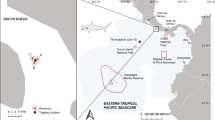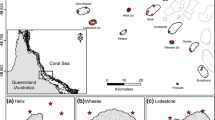Abstract
Fisheries exploitation and habitat alteration are threatening lemon shark (Negaprion bevirostris) populations because they use nearshore regions as nursery sites. As such, there is a need for information on the spatial ecology of juvenile lemon sharks to identify critical habitats that require protection, as well as to understand their basic ecology. The purpose of this study was to determine the habitat preferences and movement patterns of juvenile lemon sharks along a sub-section of coastline characterized by coastal flats and tidal creeks of Eleuthera, The Bahamas. Eleven juvenile lemon sharks (766 ± 127 mm total length; mean±SD) were captured from various tidal creeks within the 23 km study area and were surgically implanted with acoustic transmitters. A series of 27 hydrophone receivers acted as a passive monitoring array to detect tagged individuals as they moved among habitats. Findings suggest that juvenile lemon sharks tagged in this study prefer shallow water habitats within tidal creeks, and typically display high site fidelity with occasional forays to alternate habitats or creeks. In fact, more than 90% of tagged lemon sharks had the greatest percentage of detections located at a receiver at or close to the location where they were tagged. There was no evidence of differences in diel or seasonal movement and habitat use. Knowledge gained from this study will be useful for directing future conservation and management strategies including coastal development plans and marine protected areas.


Similar content being viewed by others
References
Baum JK, Myers RA (2004) Shifting baselines and the decline of pelagic sharks in the Gulf of Mexico. Ecol Lett 7:135–145
Baum JK, Myers RA, Kehler DG, Worm B, Harley SJ, Doherty PA (2003) Collapse and conservation of shark populations in the Northwest Atlantic. Science 299:389–392
Beck MW, Heck LK, Able KW, Childers DL, Eggleston DB, Gilladers BM, Haplern B, Hays CG, Hoshino K, Minello TJ, Orth RJ, Sheridan PF, Weinstein MP (2001) The identification, conservation, and management of estuarine and marine nurseries for fish and invertebrates. Bioscience 51:633–641
Brown CA, Gruber SH (1988) Age assessment of the lemon shark, Negaprion brevirostris, using tetracycline validated vertebral centra. Copeia 3:747–753
Buchan KC (2000) The Bahamas. Mar Pollut Bull 41:94–111
Camhi M, Fowler S, Musick J, Bräutigam A, Fordham S (1998) Sharks and their relatives: ecology and conservation. Occasional Paper of the IUCN Species Survival Commision Occas. Paper No. 20
Carraro RW, Glastone W (2006) Habitat preferences and site fidelity of the Ornate Wobbegong shark (Orectolobus ornatus) on rocky reefs of New South Wales. Pac Sci 60:207–223
Castro JI (1993) The shark nursery of Bulls Bay, South Carolina, with a review of the shark nurseries of the southeastern coast of the United States. Environ Biol Fish 38:37–48
Chapman DD, Pikitch EK, Babcock E, Shivji MS (2005) Marine reserve design and evaluation using automated acoustic telemetry: a case-study involving coral reef-associated sharks in the Mesoamerican Caribbean. Mar Technol Soc J 39:42–55
Christensen V, Guenette S, Heymans JJ, Walters CJ, Watson R, Zeller D, Pauly D (2003) Hundred-year decline of North Atlantic predatory fishes. Fish Fish 4:1–24
Compagno LJV (1984) FAO species catalogue of the world, vol 4: sharks of the world. An annotated and illustrated catalogue of shark species known to date, part 2: carcharhiniformes. FAO Fish Synop 125:251–665
Cooke SJ (2008) Biotelemetry and biologging in endangered species research and animal conservation: relevance to regional, national and IUCN Red List threat assessments. Endang Species Res 4:165–185
Correia J, De Marignac J, Gruber S (1995) Young lemon shark behaviour in Bimini Lagoon. Bahamas J Sci 10:2–8
Cortés E, Gruber SH (1990) Diet, feeding habits and estimates of daily ration of young lemon sharks, Negaprion Brevirostris (Poey). Copeia 1:204–218
Danylchuk AJ, Danylchuk SE, Cooke SJ, Goldberg TL, Koppelman JB, Phillipp DP (2007) Post release mortality of bonefish exposed to different handling practices during catch-and-release angling in Eleuthera, The Bahamas. Fish Manag Ecol 14:149–154
Garla RC, Chapman DD, Wetherbee BM, Shivji M (2006) Movement patterns of young Caribbean reef sharks, Carcharhinus perezi, at Fernando de Noronha Archipelago, Brazil: the potential of marine protected areas for conservation of a nursery ground. Mar Biol 149:189–199
Gruber SH (1982) Lemon sharks: supply-side economists of the sea. Oceanus 24:56–64
Gruber SH (1984) Bioenergetics of the captive and free-ranging lemon shark. AAZPA Annual Conference Proceedings. 340–373
Gruber SH (1988) Sharks of the shallows. Nat Hist 97:50–59
Gruber SH, Parks W (2002) Mega-resort development on Bimini: sound economics or environmental disaster. Bahamas J Sci 5:2–18
Gruber SH, Nelson DR, Morrissey JF (1988) Patterns of activity and space utilization of lemon sharks, Negaprion brevirostris, in a shallow Bahamian lagoon. Bull Mar Sci 43:61–76
Gruber SH, de Marignac JRC, Hoenig JM (2001) Survival of juvenile lemon sharks at Bimini, Bahamas, estimated by mark-depletion experiments. Trans Am Fish Soc 130:376–384
Heithaus MR (2004) Predator-prey interactions. In: Carrier JC, Music JA, Heithaus MR (eds) Biology of sharks and their relatives. CRC, Boca Raton, pp 487–521
Heupel MR, Simpfendorfer CA, Hueter RE (2004) Estimation of shark home ranges using passive monitoring techniques. Environ Biol Fish 71:135–142
Heupel MR, Semmens JM, Hobday AJ (2006) Automated acoustic tracking of aquatic animals: scales, design and deployment of listening station arrays. Mar Freshw Res 57:1–13
Holland KN, Wetherbee BM, Peterson JD, Lowe CG (1993) Movements and distribution of hammerhead shark pups on their natal grounds. Copeia 2:495–502
Jackson JBC, Kirby MX, Bergner WH, Bjorndal KA, Botsford LW, Bourque BJ, Bradbury RH, Cooke R, Erlandson J, Estes JA, Hughes TP, Kidwell S, Lange CB, Lenihan HS, Pandolfi JM, Peterson CH, Steneck RS, Tegner MJ, Warner RR (2001) Historical overfishing and the recent collapse of coastal ecosystems. Science 293:629–638
Kramer DL, Chapman MR (1999) Implications of fish home range size and relocation for marine reserve function. Env Biol Fishes 55:65–79
Kroese M, Sauer WH (1998) Elasmobranch exploitation in Africa. Mar Freshw Res 49:573–577
Manire C, Gruber S (1990) Many sharks may be headed toward extinction. Conserv Biol 4:10–11
McKibben JN, Nelson DR (1986) Patterns of movement and grouping of gray reef sharks, Carcharhinus amblyrhynchos, at Enewetak, Marshall Islands. Bull Mar Sci 1:89–110
Merson RR, Pratt HL Jr (2001) Distribution, movements and growth of young sandbar sharks, Carcharhinus plumbeus, in the nursery grounds of Delaware Bay. Env Biol Fishes 61:13–24
Morrissey JF, Gruber SH (1993a) Home range of juvenile lemon sharks, Negaprion brevirostris (Poey). Copeia 2:425–434
Morrissey JF, Gruber SH (1993b) Habitat selection by juvenile lemon sharks, Negaprion brevirostris. Environ Biol Fish 38:311–319
Myers RA, Baum JK, Shepherd TD, Powers SP, Peterson CH (2007) Cascading effects of the loss of apex predatory sharks from a coastal ocean. Science 315:1846–1850
Stevens JD, Bonfil R, Dulvy NK, Walker PA (2000) The effects of fishing on sharks, rays, and chimaeras (chondricthyans), and the implications for marine ecosystems. ICES J Mar Sci 57:476–494
Sundström LF, Gruber SH, Clermont SM, Correia JPS, de Marignac JRC, Morrissey JF, Lowrance CR, Thomassen L, Oliveira MT (2001) Review of elasmobranch behavioral studies using ultrasonic telemetry with special reference to the lemon shark, Negaprion brevirostris, around Bimini Islands, Bahamas. Environ Biol Fish 60:225–250
Voegeli FA, Webber DM, Smale MJ, Andrade Y, O'Dor RK (2001) Ultrasonic telemetry, tracking and automated monitoring technology for sharks. Environ Biol Fish 60:267–281
Walker TI (1998) Can shark resources be harvested sustainably? A question revisited with a review of shark fisheries. Mar Freshw Res 49:553–572
Watsky MA, Gruber SH (1990) Induction and duration of tonic immobility in lemon shark, Negaprion brevirostris. Fish Physiol Biochem 8:207–210
Wetherbee BM, Gruber SH, Rosa RS (2007) Movement patterns of juvenile lemons sharks Negaprion brevirostris within Atol das Rocas, Brazil: a nursery characterized by tidal extremes. Mar Ecol Prog Ser 343:283–293
Acknowledgements
We gratefully acknowledge C. Maxey and the staff, students, and volunteers of the Cape Eleuthera Institute and The Island School for logistical support and assistance with field work. In particular, A. Schultz, E. Brooks, A. Oronti, S. Langosch, and T. Voorhees. We also thank other research staff including J. Koppelman, J. Claussen, M. Philipp, and M. Philipp. This project was supported by a grant from the Charles A. and Anne Morrow Lindbergh Foundation. Additional financial support was provided by the Canadian Foundation for Innovation, the Ontario Research Fund, Carleton University, the Cape Eleuthera Foundation, Bonefish & Tarpon Unlimited, and the University of Illinois. K. Murchie was supported by a Natural Sciences and Engineering Research Council CGSD fellowship. We also thank The Bahamas Department of Marine Resources for their support.
Author information
Authors and Affiliations
Corresponding author
Rights and permissions
About this article
Cite this article
Murchie, K.J., Schwager, E., Cooke, S.J. et al. Spatial ecology of juvenile lemon sharks (Negaprion brevirostris) in tidal creeks and coastal waters of Eleuthera, The Bahamas. Environ Biol Fish 89, 95–104 (2010). https://doi.org/10.1007/s10641-010-9693-y
Received:
Accepted:
Published:
Issue Date:
DOI: https://doi.org/10.1007/s10641-010-9693-y




